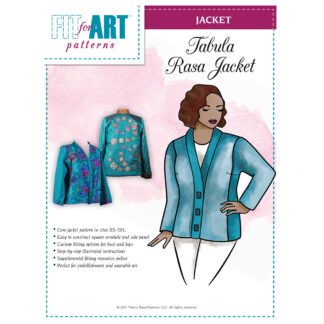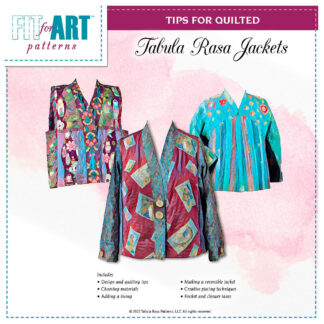We hope you find this glossary of common sewing terms helpful while you sew. If you do not see a particular definition, we recommend that you visit Threads Magazine’s glossary for even more terms.
Backstitching: This easy stitch forward / stitch in reverse / stitch forward process is used at the beginning and ending of each seam that needs to be stable when sewing. Two or three stitches is all you need to lock the seam threads in place.
Binding: Wrapping fabric around a raw surface of a garment, bag, or quilt is called binding. A classic binding has a clean finish on each side, usually folded and stitched in place. Read our Seams Logical document (PDF) for a more thorough description. A more modern type of banding attaches a folded binding as an edge finish. Follow the directions in our blog post, “Finish a Carpe Diem with Binding.”
Clean Finish: This term refers to how seams are finished to keep the seam allowance from becoming ravely. The industry standard is a serger overlock edge, but there are many other options discussed in our Seams Logical document (PDF) and in our blog post, “What is a Clean Finish?”
Cutting Line: In contemporary patterns, the cutting line is the line, marked with your desired size, on the multi-sized pattern. It is along this line that you cut out the pattern. Once you place the pattern on the fabric, it is the line you follow to cut out the fabric.
Dots: Dots are common markings on paper and digital patterns that offer a guide to joining cut and seamed sections along the seam line. Dots sit inside the cutting line along the designated seam line. Read more in our blog post, “Dots and Notches.”
Facings: In many garments, you are prompted to finish the raw edges with facings. A well-made pattern will include patterns for these facings that match the base garment patterns. In the Fit for Art pattern line, you will find facings in the Carpe Diem Dress and Shirt, Rain or Shine Variations and Jean Jacket Variations of the Tabula Rasa Jacket, and the faced versions of the Eureka! Pants that Fit. If you have made fitting or design changes to the base pattern, be sure to make the same adjustments to the facing pattern or the garment will not fit together properly.
French Seams: A lovely finish, this seam within a seam is made in two parts. Follow the directions in our Seams Logical document (PDF) or in the blog post, “Elegant French Seams.” Add french seams to a Carpe Diem dress for a couture finish or use them in an unlined Tabula Rasa or Tabby Jacket.
Gathering Stitches: These lines of long stitches are used to draw up fabric in a sleeve, skirt, or pair of pants. In the Fit for Art pattern line, gathering stitches appear at the top of the sleeves in the Tabula Rasa Jacket, Sleeve and Cuff Variation, Tabby Jacket, and Carpe Diem Dress. It is ideal to have at least two parallel rows of stitching inside the sleeve seam allowance. Do not backstitch these rows of long stitches, but leave the thread tails so the fabric can be drawn up into the desired size.
Hong Kong Finish: This seam or edge finish wraps around a raw edge and is topstitched into place. Read our Seams Logical document (PDF) or our blog post, “What Is a Clean Finish?” for more information.
Notches: These common markings on paper and digital patterns offer a guide to joining the cut sections along the cutting lines. Read more in our blog post, “Dots and Notches.”
Press Seams Open or to One Side: Once a seam is sewn, it can be pressed one of two ways. The two seam allowances can be pressed apart, which is called pressing the seam open. When pressed open, each seam allowance should be clean finished separately. Pressing a seam open distributes the bulk created by the seam inside a garment. Shoulder seams are often pressed open to keep neck edges smooth. Seams pressed to one side is a technique that became common practice when clothing became wash and wear. The two seam allowances are clean finished together and then pressed to one side. Fit for Art’s patterns offer directions as to the ideal way to press seams when creating a garment.
Seam Allowance: The seam allowance is the amount of fabric that has been added to a pattern for the seam. Sewing along the designated seam line to create the seam allowance will assure an expected fit. Many garment patterns for sewists allow for a ⅝” seam allowance. This is enough for the seam to remain strong but also offers enough fabric that if the garment is too tight, it can be released. Fit for Art’s patterns use a consistent ⅝” seam allowance.
Seam Line: While seam lines are not generally included on a multi-sized pattern, they can be very helpful if fitting work is needed and adjustments need to be annotated. Check the seam allowance in the pattern you are using and, if desired, draw seam lines on the paper pattern inside the cutting line. Fit for Art’s patterns use a consistent ⅝” seam allowance.
Stay Stitching: This line of stitching is added before construction to keep curved edges from stretching during construction. It is usually stitched ½” from the cut edge so it falls just inside the seam line. That provides the best insurance that the area will stay stable during construction. It is the first step in many of Fit for Art’s patterns for woven garments.
Understitching: A line of straight stitching close to the edge of a garment or attaching seam allowances to an internal finish like a facing, to secure seam allowances, prevent the edge from stretching, and support the fabric. In sewing garments, this stitching is used to anchor the clipped and graded seam allowances to the facing in a neckline, waist finish, or armhole. It is also sometimes referred to as edge stitching. You will find understitching in the Carpe Diem Dress and Shirt, Rain or Shine Variations and Jean Jacket Variations of the Tabula Rasa Jacket, and the faced versions of the Eureka! Pants that Fit.
Walk the Pattern: If a number of pattern changes have been made to any garment sewing pattern to adjust the fit or design, be sure to walk the patterns that must fit together before actually cutting and sewing with them. Align any two pattern pieces that are designed to fit together and move your finger along the seam line, shifting the patterns as necessary, to make sure the seams will attach evenly. This is especially important in the Eureka! Pants that Fit pattern where the waist line is added as the pattern work is finished. Our colleague Sarah Veblen has written an excellent set of directions on walking the pattern in a sidebar of the Eureka! Pants instruction book.






